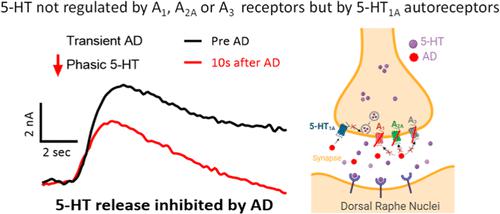当前位置:
X-MOL 学术
›
ACS Chem. Neurosci.
›
论文详情
Our official English website, www.x-mol.net, welcomes your feedback! (Note: you will need to create a separate account there.)
Transient Adenosine Modulates Serotonin Release Indirectly in the Dorsal Raphe Nuclei
ACS Chemical Neuroscience ( IF 4.1 ) Pub Date : 2024-02-09 , DOI: 10.1021/acschemneuro.3c00687 Kailash Shrestha 1 , B. Jill Venton 1
ACS Chemical Neuroscience ( IF 4.1 ) Pub Date : 2024-02-09 , DOI: 10.1021/acschemneuro.3c00687 Kailash Shrestha 1 , B. Jill Venton 1
Affiliation

|
Rapid adenosine transiently regulates dopamine and glutamate via A1 receptors, but other neurotransmitters, such as serotonin, have not been studied. In this study, we examined the rapid modulatory effect of adenosine on serotonin release in the dorsal raphe nuclei (DRN) of mouse brain slices by using fast-scan cyclic voltammetry. To mimic adenosine release during damage, a rapid microinjection of adenosine at 50 pmol was applied before electrical stimulation of serotonin release. Transient adenosine significantly reduced electrically evoked serotonin release in the first 20 s after application, but serotonin release recovered to baseline as adenosine was cleared from the slice. The continuous perfusion of adenosine did not change the evoked serotonin release. Surprisingly, the modulatory effects of adenosine were not regulated by A1 receptors as adenosine still inhibited serotonin release in A1KO mice and also after perfusion of an A1 antagonist (8-cyclopentyl-1,3-dipropyl xanthine). The inhibition was also not regulated by A3 receptors as perfusion of the A3 antagonist (MRS 1220) in A1KO brain slices did not eliminate the inhibitory effects of transient adenosine. In addition, adenosine also inhibited serotonin release in A2AKO mice, showing that A2A did not modulate serotonin. However, perfusion of a selective 5HT1A autoreceptor antagonist drug [(S)-WAY 100135 dihydrochloride] abolished the inhibitory effect of transient adenosine on serotonin release. Thus, the transient neuromodulatory effect of adenosine on DRN serotonin release is regulated by serotonin autoreceptors and not by adenosine receptors. Rapid, transient adenosine modulation of neurotransmitters such as serotonin may have important implications for diseases such as depression and brain injury.
中文翻译:

瞬时腺苷间接调节中缝背核中的血清素释放
快速腺苷通过 A 1受体短暂调节多巴胺和谷氨酸,但尚未研究其他神经递质,例如血清素。在这项研究中,我们通过使用快速扫描循环伏安法检查了腺苷对小鼠脑切片中缝背核(DRN)中血清素释放的快速调节作用。为了模拟损伤过程中腺苷的释放,在电刺激血清素释放之前,快速显微注射 50 pmol 的腺苷。瞬时腺苷在应用后的前 20 秒内显着减少了电诱发的血清素释放,但随着腺苷从切片中清除,血清素释放恢复到基线。腺苷的连续灌注不会改变诱发的血清素释放。令人惊讶的是,腺苷的调节作用不受 A 1受体调节,因为腺苷仍然抑制 A 1 KO 小鼠中以及灌注 A 1拮抗剂(8-环戊基-1,3-二丙基黄嘌呤)后的血清素释放。该抑制也不受 A 3受体调节,因为在 A 1 KO 脑切片中灌注 A 3拮抗剂(MRS 1220)并不能消除瞬时腺苷的抑制作用。此外,腺苷还抑制A 2A KO小鼠的血清素释放,表明A 2A不调节血清素。然而,灌注选择性5HT 1A自身受体拮抗剂药物[(S)-WAY 100135 二盐酸盐]消除了瞬时腺苷对血清素释放的抑制作用。因此,腺苷对 DRN 血清素释放的短暂神经调节作用是由血清素自身受体而不是腺苷受体调节的。神经递质(如血清素)的快速、短暂的腺苷调节可能对抑郁症和脑损伤等疾病具有重要意义。
更新日期:2024-02-09
中文翻译:

瞬时腺苷间接调节中缝背核中的血清素释放
快速腺苷通过 A 1受体短暂调节多巴胺和谷氨酸,但尚未研究其他神经递质,例如血清素。在这项研究中,我们通过使用快速扫描循环伏安法检查了腺苷对小鼠脑切片中缝背核(DRN)中血清素释放的快速调节作用。为了模拟损伤过程中腺苷的释放,在电刺激血清素释放之前,快速显微注射 50 pmol 的腺苷。瞬时腺苷在应用后的前 20 秒内显着减少了电诱发的血清素释放,但随着腺苷从切片中清除,血清素释放恢复到基线。腺苷的连续灌注不会改变诱发的血清素释放。令人惊讶的是,腺苷的调节作用不受 A 1受体调节,因为腺苷仍然抑制 A 1 KO 小鼠中以及灌注 A 1拮抗剂(8-环戊基-1,3-二丙基黄嘌呤)后的血清素释放。该抑制也不受 A 3受体调节,因为在 A 1 KO 脑切片中灌注 A 3拮抗剂(MRS 1220)并不能消除瞬时腺苷的抑制作用。此外,腺苷还抑制A 2A KO小鼠的血清素释放,表明A 2A不调节血清素。然而,灌注选择性5HT 1A自身受体拮抗剂药物[(S)-WAY 100135 二盐酸盐]消除了瞬时腺苷对血清素释放的抑制作用。因此,腺苷对 DRN 血清素释放的短暂神经调节作用是由血清素自身受体而不是腺苷受体调节的。神经递质(如血清素)的快速、短暂的腺苷调节可能对抑郁症和脑损伤等疾病具有重要意义。
















































 京公网安备 11010802027423号
京公网安备 11010802027423号